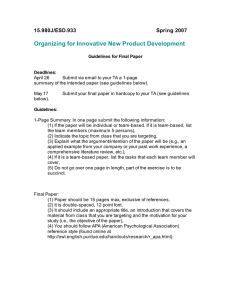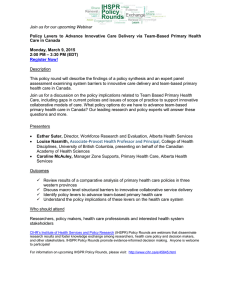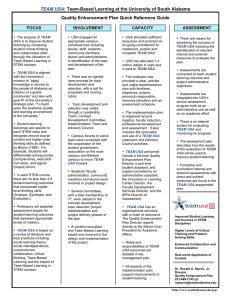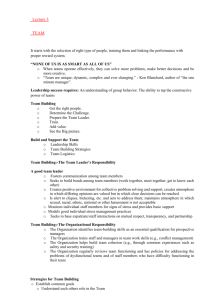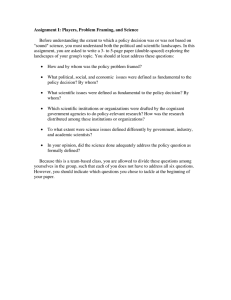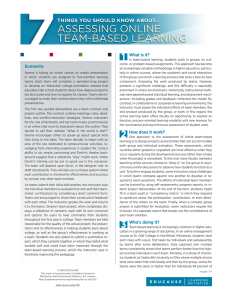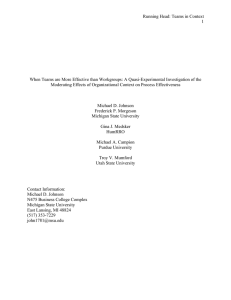15.660 Strategic Human Resource Management MIT Sloan School of Management
advertisement
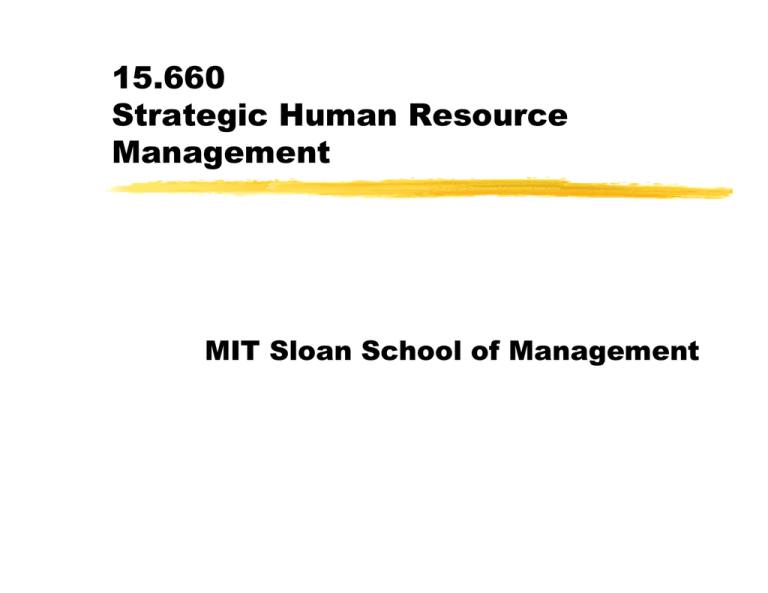
15.660 Strategic Human Resource Management MIT Sloan School of Management Eliciting Effort ? ? ? ? Pay Benefits Promotion Monitoring By Peers ? By Management ? ? Culture Mini-Lecture Teams Effective Use of Team-Based Systems ? ? ? ? ? ? What is a team-based system? Costs and benefits of using teams? What is the leader’s role in a team-based organization? What skills are needed for teams to function effectively? How can you introduce a team-based system? Overall lessons learned? What is a Team? A A team team is is aa small small number number of of people people with with complementary complementary skills skills who who are are committed committed to to aa common common purpose, purpose, performance performance goals, goals, and and approach approach for for which which they they hold hold themselves themselves mutually mutually accountable. accountable. John Katzenbach and Douglas Smith, McKinsey & Company The Wisdom of Teams Harvard Business School Press, 1993 Working Groups Versus Teams WORKING GROUP ? ? ? ? ? ? ? TEAM Strong, clearly-focused leader Individual accountability ? Group’s purpose is same as the organization’s Individual work products Runs efficient meetings Measures performance in terms of larger firm Discusses, decides, and delegates ? ? ? ? ? ? Shared leadership roles Individual and mutual accountability Specific purpose for which the team is responsible Collective work products Open-ended meetings for problem-solving Performance measured on team products Discuss, decide, and work together Common Team Responsibilities ? ? ? ? ? ? ? ? ? ? ? Quality improvement Cross-training Scheduling (Production) Safety Process improvement Measurement/goal-setting Budget/expense control Selection Coordination with others Customers and suppliers Performance appraisal 100% 85% 80% 70% 70% 75% 50% 55% 50% 60% 50% Manz and Sims (1993) Costs/Benefits of Using Teams Benefits ? ? ? ? Bring together complementary skills and experiences Provides for flexibility Social benefits: fun, commitment Less resistant to change Costs ? ? ? ? Coordination costs Personal discomfort and conflict Diffusion of responsibility (freeriders and social loafing) Risk seeking What is the role of the leader in a team-based system? • Ask questions • Get the group to solve problems • Promote real participation • Help resolve conflict • Train others • Positive reinforcement • Encourage high performance goals • Encourage self-evaluation • Tell the truth, even when it’s disagreeable • Liaison with higher management What Effective Team Leaders Do ? ? ? ? ? ? Keep purpose, goals, and approach relevant and meaningful Build commitment and confidence Manage the level and mix of skills Manage relationships with outsiders Create opportunities for others Do real work Team Development S S S = Supervisor S Mature Experienced S Transitional Start Start -- up up C. Manz & H. Sims Business Without Bosses John Wiley, 1993 What types of skills and training are required for a team-based system? Training for Team Effectiveness ? ? ? ? ? ? ? ? Meeting skills, time management Conflict management Problem-solving, TQM Group dynamics, team building Change management Coaching and feedback Business knowledge (e.g., customer service) Technical skills Evidence on Team Effectiveness ? ? ? ? ? ? ? ? ? Cost savings (labor, materials) Productivity Quality Customer service Speed and cycle time Innovation Safety Decreased absenteeism and turnover Decreased worker’s compensation claims Pros Pros and and Cons Cons of of aa Team-Based Team-Based Approach? Approach? Pros Cons Lessons Learned: Implementing Team-based Systems High Performance Team Real Team Impact Working Group Potential Team PsuedoTeam Team Performance Some Lessons Learned the Hard Way ? ? ? ? ? ? ? ? ? ? ? ? ? Organizations often expect too much, too soon. Things often get worse before they get better. Managers and supervisors are threatened. A new perspective on leadership is required. Need to begin with a clear philosophy and purpose. Technical people often see themselves as losers. Implementation needs careful planning. Employees need technical and behavioral skills. Greenfield sites are easier than retrofits. Continuous training is essential. Stability is crucial; turnover is deadly. May need new systems - especially MIS. Facilitation can help at the beginning. Takeaways ? ? ? Teams need to be driven by a clear vision and purpose--why are we using them? Training and group process skills are important for groups to succeed. Team-based organizations need teambased systems, culture, and leadership-not just structure. Conclusion ? Next Class: ? Eastern Airlines
